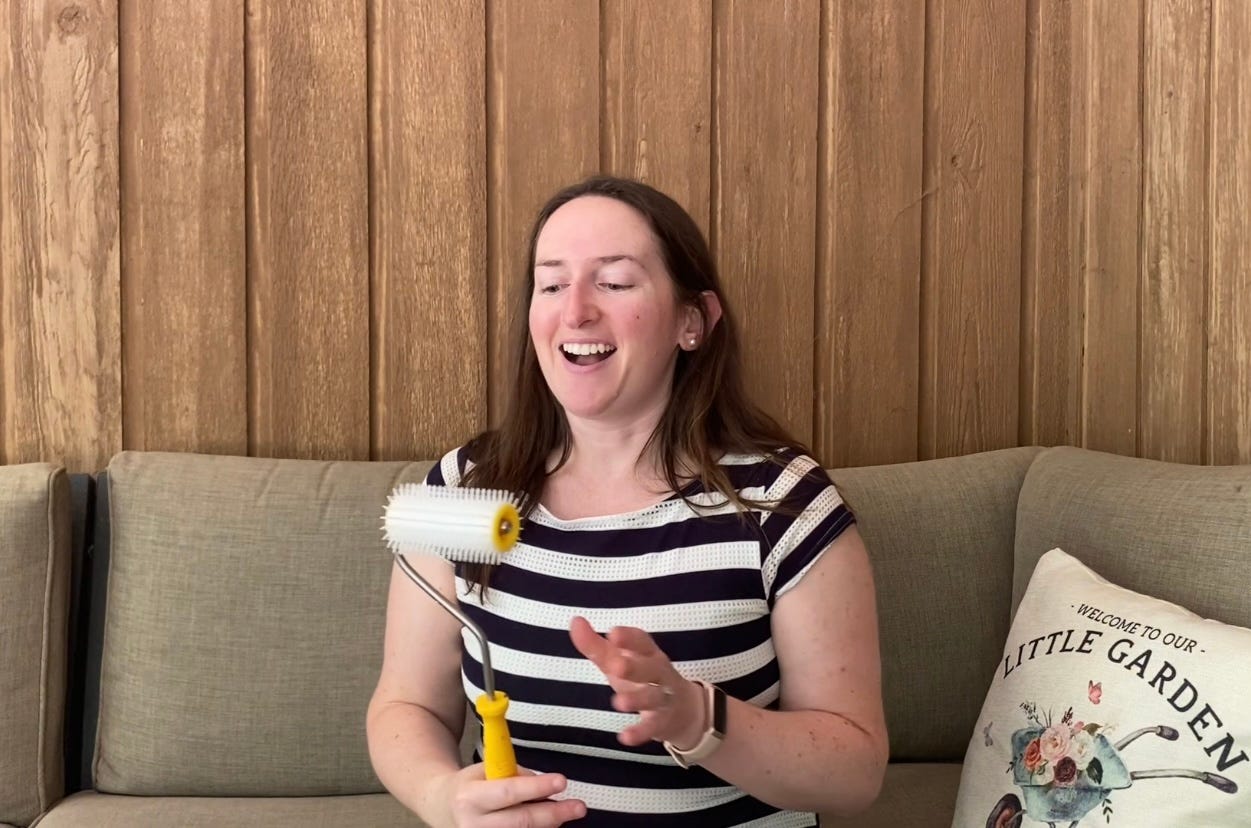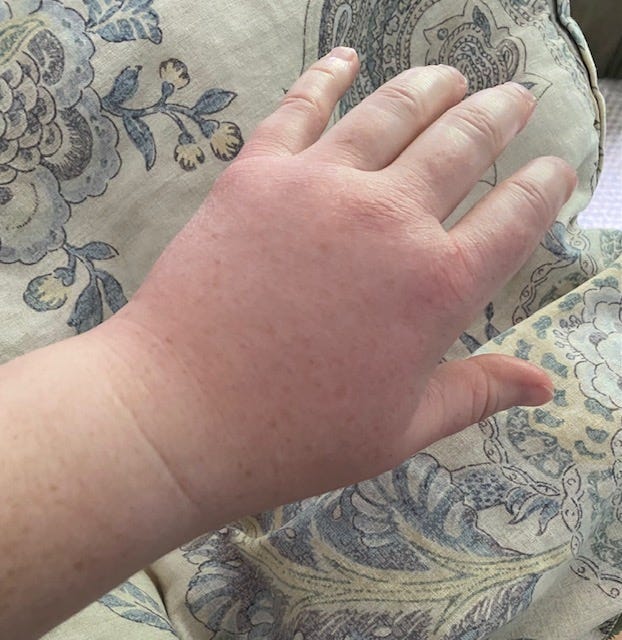Everything that went wrong with the honey harvest
Honey harvest day turned into a series of unfortunate events.
Generally I find satisfaction with honey harvests. Although it’s a lot of physical work, I feel it’s rewarding. However, I’ve usually just extracted from 2–3 hives. This year I have 16 between all my bee yards (although I didn’t plan on harvesting from all). I planned to extract from 6 of my Pittsboro, North Carolina hives. Some beekeepers take all of the bees’ excess honey, which means they need to feed the bees during the summer dearth. Late summer is a critical time for brood production because the bees born in the fall will need to keep the queen alive all winter. To me, summer nutrition for bees is the most important of the year. I harvest excess honey, but I only take 1/3 or less from any colony I harvest from.
Preparing the hives for harvest day
In the week leading up to harvest day, I organized the top boxes (supers) and frames so that the most ideal frames were at the top. I also added an escape board—but this was my first mistake on 2 points. One, I left the majority of my escape board adapters at my mountain apiary. I only had 1 in Pittsboro. Two, I learned that escape boards are great for letting workers out and preventing them from getting back in – but they don’t let drones out. In the hive that I used an escape board, I had 2 supers full of drones. Drones don’t sting, but they consume 3 times as much food as a worker bee. Fortunately, I only left the escape board on for 2 days prior to harvest, but it’s not an ideal situation to leave hungry boys trapped in a full pantry.
Now I’ll share a rundown of how the misfortunes piled up throughout the day, essentially at the same scale honey was flowing.
Day in the life of honey harvesting
Morning prep
Line up buckets, set up cardboard “rest areas” around the extractor where supers will sit before/after extraction, turn down the AC to help keep temperatures even and humidity low, set up a fan facing the super rest area to further help control moisture. Since I have more hives than ever this year, I decided to label each super so that I could return each one to the appropriate hive.
12:00
Thinking of my future self, I decided to make a Crock-Pot dinner. I took a pork butt out of the freezer the night before. I added it to the Crock-Pot and set it on Low. (Little did I know I did NOT plug it in!)
12:30-3:30
Learned about my escape board mistake that I described earlier. Used a fume board to encourage bees to leave the supers. A fume board is a felt top that you can spray with aromas that the bees don’t like. Ironically, bees don’t like almond oil even though they’re responsible for pollinating most of the world’s almonds. The fume board has always worked great for me, but for some reason the last 2 hives that I used it on didn’t seem successful. Those supers were entirely full of bees.
After I filled the truck bed and part of the cab with supers, I drove to my front porch where I took each frame out 1-by-1 and made sure no bees were left. I have an empty super set up on the porch where I rest the frames, then double-check them 1-by-1 again before moving them into the house. Throughout the process I noticed not 1, not 2, but at least a dozen frames were overflowing with so much honey that the comb was falling out of the frame—and these were frames that bees had built from wired wax foundation, which should have been the most secure to extract from. These overflowing frames that were falling apart were completely unextractable. Some of them I rubber-banded to hold together before adding back to the hive. Between the frames falling apart and the few supers that hadn’t been cleared of bees – I came very close to giving up. It all felt like too much of a hassle. I was feeling nauseous from the heat. Everything was taking too long.
Between the frames falling apart and the few supers that hadn’t been cleared of bees – I came very close to giving up.
I also learned that my early work at organizing the supers the week before wasn’t entirely successful. One of the reasons why I organize the supers is to avoid finding brood in the frames. Sure enough, one of my newer queens decided the supers were a lovely place to lay. In between my frame clearing I had to walk one of the supers back to that colony so that the eggs and larvae didn’t go without nurse bees.
3:30 p.m.
Feeling even more nauseous from heat exhaustion, I stopped for a few minutes to de-suit and re-hydrate. While doing this, I checked the Crock-Pot and learned that I had never plugged it in! Fortunately, the pot had insulated the pork and it was still very cold to the touch, so I put it in the fridge. (We enjoyed it the next day and it was fantastic.)
3:45 p.m. – 8:15 p.m.
Nonstop uncapping, spinning, and bucket-filling. I don’t save the wax cappings from the frames. Instead, I use a roller. It looks like a lint roller, but it’s covered in spikes and breaks the wax cappings so that the honey can flow. The roller I use to break the caps kept getting clogged. I stopped between each spin to scrape wax out of the roller.

I harvest honey in a hand-cranked extractor. As the extractor spins, honey flows out to the sides, and then settles at the bottom. If the extractor starts to get too full of honey, it can’t spin. I found the extractor was filling faster than I was able to extract, so I had to wait on gravity to fill buckets. This was a slow process because I use a large filter on the buckets. Wax capping debris kept collecting on the filter and slowing down the bucket-filling flow.

8:15 p.m.
My husband came home with takeout dinner, but I had 3 frames left to extract and sunset was at 8:23. I always get the wet supers back on the hives at sunset, which allows the bees time to clean things up before morning. It’s best to avoid adding wet supers during the day because it attracts robber bees and other pests.
8:30 p.m.
I got the wet supers back on the truck and drove over to the hives. I got the first hive of 6 done. Then the second. That’s when I got stung the first time on the wrist. The bee had picked the ventihilation band on my gloves. With losing daylight, I could barely see what I was doing, but I could hear bees all over my veil and realized they were going under an extra shirt I wear over my gloves. I got the third hive settled as bees stung my other wrist. I was getting stung more times than I can count. Then I decided to abort.
I closed the truck up with the remaining wet supers, got to the porch and had my husband “clear” me like I was in a hazmat chamber, making sure no other gals were on me before coming in the house.

9:15 p.m.
When I took off my gloves I learned that somehow the first stinger and venom sac were still stuck on my wrist. This meant for about a half hour venom was continuously flowing into my wrist. I threw my gear into the laundry, took Benadryl, and ate takeout on the couch.
Getting stung around my wrists meant I had limited mobility. Taking Benadryl meant I was woozy and tired. I spent the rest of the long weekend in bed, which was painful on another level: Seeing perfect spring weather outside my window (on one of the days) and not able to enjoy it.
What I’ll do differently at the next honey harvest
I’ll selectively remove extractable frames in the week or 2 before harvest. Taking them out in early batches can help prevent the surprise of unextractable frames, challenges of removing bees from supers, and heat exhaustion.
I might accept help. My beekeeping mentor and a few other beekeeper friends offered to help me after hearing of my woes. Having extra sets of hands would make moving supers less stressful, and can keep the harvest line of tasks (like unclogging the uncapping roller) moving in tandem instead of me stopping to address each challenge.
I’ll only use escape boards when I see low populations of drones in the supers. Now I know not to trap those fellas in the pantry. The underlying benefit of these boards though is that the queen can’t travel up and turn the supers into her nursery.
I’ll never add wet supers back after sunset again. I’ll save extra cardboard to make space in the house for the supers to rest until sunset the following day. No need for twilight stings again!
I’ll move unextractable frames lower in the supers for the bees to keep. Less for me to carry into the house only to return it back to the hives.
Have you had challenges with honey extractions?



